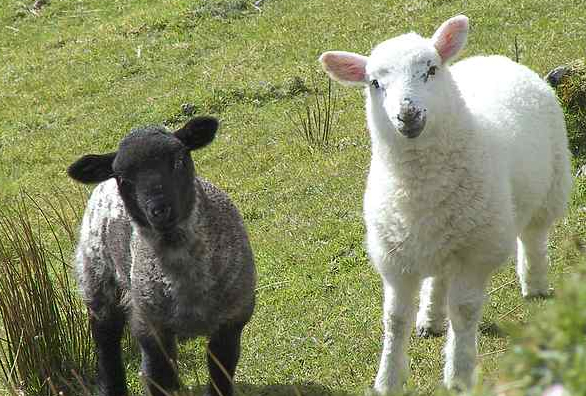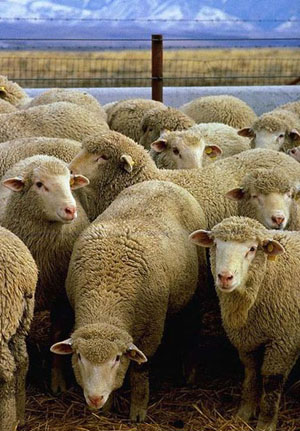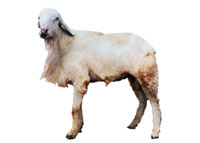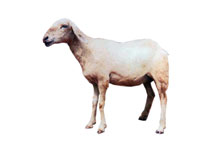Sheep Farming

Source: http://www.reggie.net/
Sheep with its multi-facet utility for wool, meat, milk, skins and manure, form an important component of rural economy particularly in the arid, semi-arid and mountainous areas of the country. It provides a dependable source of income to the shepherds through sale of wool and animals. The advantages of sheep farming are :
i)Sheep do not need expensive buildings to house them and on the other hand require less labour than other kinds of livestock.
ii)The foundation stock are relatively cheap and the flock can be multiplied rapidly.
iii)Sheep are economical converter of grass into meat and wool.
iv)Sheep will eat varied kinds of plants compared to other kind of livestock. This makes them excellent weed destroyer.
v)Unlike goats, sheep hardly damage any tree.
vi)The production of wool, meat and manure provides three different sources of income to the shepherd.
vii)The structure of their lips helps them to clean grains lost at harvest time and thus convert waste feed into profitable products.
viii)Mutton is one kind of meat towards, which there is no prejudice by any community in India and further development of superior breeds for mutton production will have a great scope in the developing economy of India.
The country has 56.8 million sheep as per 1997 livestock census and ranks sixth in the world. The statewise sheep population are given in Annexure I. During 2001-02 wool production stands at the modest level of 50.709 million, skin with wool sheep 524 MT, sheep and goat meat 700500 MT in 2001-02, sheep fresh 52380 MT. The export earnings from different woollen products during 1994-95 was Rs.25773 million. The contribution of sheep to total meat production in the country is around 14 percent. The contribution of sheep through export of meat is 8 percent of the total export value of agricultural and processed food products. Live sheep are also exported for meat purpose. Sheep skin in the form of leather and leather products is also exported.
Sheep make a valuable contribution to the livelihood of the economically weaker sections of the society. Amongst the livestock owners the shepherds are the poorest of the lot.
Realising the importance of sheep in Agrarian economy the Central Government had established the Central Sheep and Wool Research Institute (CSWRI) at Avikanagar in Rajasthan. Number of sheep breeding farms were established during various plan periods throughout the country for evolving (i) new fine wool breeds for different agro-climatic regions capable of producing 2.5 kg. of greasy wool per annum. (ii) new mutton breeds capable of attaining 30 kg. live weight at 6 months of age under intensive feeding conditions. Sheep development activities were initiated under :
DPAP, MFAL and SFDA programmes. Intensive Sheep Development Projects (ISDP's) were introduced in many of the sheep rearing districts. Setting up of wool boards in important wool producing states was envisaged and States of Jammu & Kashmir and Karnataka have already set up these boards. Some of the states have set up wool development corporations / federations.
STATEWISE SHEEP POPULATION IN INDIA - 1997
Sl No. |
States/U.T.s |
Total |
1 |
Andhra Pradesh |
9743 |
2 |
Arunachal Pradesh |
27 |
3 |
Assam |
84 |
4 |
Bihar |
1956 |
5 |
Chattisgarh |
196 |
6 |
Goa |
0 |
7 |
Gujarat |
2158 |
8 |
Haryana |
1275 |
9 |
Himachal Pradesh |
1080 |
10 |
Jammu & Kashmir |
3170 |
11 |
Karnataka |
8003 |
12 |
Kerala |
3 |
13 |
Madhya Pradesh |
657 |
14 |
Maharashtra |
3368 |
15 |
Manipur |
8 |
16 |
Meghalaya |
17 |
17 |
Mizoram |
1 |
18 |
Nagaland |
2 |
19 |
Orissa |
1765 |
20 |
Punjab |
436 |
21 |
Rajasthan |
14585 |
22 |
Sikkim |
5 |
23 |
Tamil Nadu |
5259 |
24 |
Tripura |
6 |
25 |
Uttar Pradesh |
1905 |
26 |
Uttaranchal |
311 |
27 |
West Bengal |
1462 |
|
Union Territories |
|
28 |
Andaman & Nicobar Islands |
0 |
29 |
Chandigarh |
0 |
30 |
Dadra & N Haveli |
0 |
31 |
Daman & Diu |
0 |
32 |
Delhi |
11 |
33 |
Lakshadweep |
0 |
34 |
Pondicherry |
2 |
|
All INDIA |
57494 |
S.No. |
STATE SHEEP AND WOOL BOARDS / FEDERATIONS / CORPORATIONS |
1. |
APCO Wool,
3-5-770. Weavers Bhawan,
Narayan Guda,
Hyderabad - 500 029 (AP) |
2. |
Gujarat Sheep & Wool Development Corporation Limited
"Shreekunj" Opp. Navarangpura Telephone Exchange
Ellisbridge,
Ahmedabad - 380 006 (Guj.) |
3. |
Himachal Pradesh State Co-operative Wool Procurement and
Marketing Federation Limited,
Pashudhan Bhawan, Boileauganj,
Shimla - 171 005 (HP) |
4. |
Jammu & Kashmir State Sheep & Sheep Products Development Board.
Kartholi, Bari Brahmana,
Jammu - 181 133 (J&K) |
5. |
Karnataka Sheep & Sheep Products Development Board
No. 58, IInd Main Road, Vyalikaval,
Bangalore - 560 003 (Karnataka) |
6. |
Maharashtra Mendhi Va Sheli VIkas Mahamandal Limited
Mendhi Farm, Gokhale Nagar,
Pune - 411 016 (Maha.) |
7. |
Rajasthan State Co-operative Sheep & Wool Marketing
Federation Limited.
Gandhi Nagar, Tonk Road,
Jaipur (Raj.) |
8. |
Uttar Pradesh Poultry & Livestock Specialities Limited,
Directorate of Animal Husbandry,
Badshah Baug, Gorakh Nath Road
Lucknow (U.P.) |
REGION WISE DISTRIBUTION OF SHEEP BREEDS IN INDIA
North Western arid and semi-arid region |
Southern peninsular region |
Eastern region |
Northern temperature region |
Chokla |
Deccani |
Chottanagpuri |
Gaddi |
Nali |
Bellary |
Shahabadi |
Rampur |
Marwari |
Nellore |
Balangir |
Bushair |
Magra |
Mandya |
Ganjam |
Bhakarwal |
Jaisalmeri |
Hassan |
Tibetan |
Poonchi |
Pungal |
Macheri |
Bonpala |
Gurez |
Malpura |
Kilakarsal |
|
Kashmir Merino |
Sonadi |
Vembur |
|
Changathangi |
Pattanwadi |
Coimbatore |
|
|
Muzzafarnagri |
Nilgiri |
|
|
Jalauni |
Ramnad white |
|
|
Hissardale |
Madras red |
|
|
|
Tiruchy black |
|
|
|
Kenguri |
|
|
WOOL PRODUCTION AND QUALITY IN DIFFERENT REGIONS OF INDIA
| S. No. |
Particulars |
North |
North Western |
Southern Temperature |
Eastern Peninsular |
1 |
Sheep population (million) |
20.36 |
3.45 |
'19.80 |
4.6 |
2 |
Percent contribution |
42.23 |
7.15 |
41.07 |
9.54 |
3 |
Wool production (m.kg) |
25.11 |
4.03 |
7.68 |
1.57 |
4 |
Percent contribution to total |
'65.40 |
'10.50 |
'20.00 |
'4.10 |
5 |
Per capita production (kg) |
1.23 |
1.16 |
0.38 |
0.34 |
6 |
Fineness (micron) |
30.45 |
22.3 |
'40.60 |
'50-60 |
7 |
Medullation (%) |
'30.80 |
5.15 |
'60.80 |
'80-90 |
8 |
Burr content (%) |
2-5 |
2-8 |
Below 5 |
1-3 |
9 |
Yield (washed) (%) |
'80-90 |
'50-60 |
'80-90
(except Nilgiri) |
'85-90 |
TRAINING INSTITUTIONS IN SHEEP FARMING
i) Central sheep and wool Research Institute, Avikanagar (Rajasthan).
ii)Central sheep and wool Research Institute (sub-station), Bikaner (Rajasthan).
iii)Central Sheep and Wool Research Institute (sub-station) Garsa (Himachal-Pradesh).
iv) Sheep and wool training centres - established by Department of Animal Husbandry in respective states.
Economics of Sheep rearing (20 Ewes + 1 Ram)
A. Unit cost of Sheep Development for Meat and Wool
i. Cost of 20 ewes @ Rs. 1200/- Rs. 24000
ii. Cost of 1 ram @ Rs. 1600/- Rs. 1600
iii. Cost of Shed, equipment and miscellaneous expenditure. Rs. 3000
iv. Total Cost Rs. 28600
v. Margin at 15% of the Total Cost Rs. 4300
vi. Loan Amount Rs. 24300
B) Techno economic parameters
Veterinary expenses have been assumed as adult Rs10, young Rs.5/-
1.The present unit cost of one year Ewes and ram is taken at Rs 1200 and Rs.1600 respectively.
2.Lambing interval is taken as 12 months with lambing percentage of 75 and sex ratio of 50:50.
3.Mortality is considered as 10 % and 5 % among lambs and adults.
4.All female lambs are retained in the flock and males are sold at 8 to 9 months of age.
5.The culling rate among ewes is 20 % and above from third year onwards.
6.Grazing charges @ Rs 4/- per adult per year.
7.Cost of concentrate feed per pregnant Ewe for 30 days @ 250 gms/animal costing Rs 5.00/kg.
8.Insurance is 4 % per year and cost of veterinary aid is Rs 10 & 5 per adult and young animal per year.
9.Shearing will be done twice a year. The adult sheep will yield 1.2 kg wool per year and the lamb will yield 600 gm. per year. The shearing charges are Rs 2.00/kg and the price of wool is Rs 40 per kg.
10. Sale price is Rs. 800 per ram lamb, Rs.1000 per adult ewe and RS. 1200 per adult ram. The sale value of closing stock is considered for working out cash flow analysis.
11.Penning charges are Rs 8 per adult animal per month for 6 months in a year.
12. The economics have been worked out basing on the opening stock.
FLOCK PROJECTION CHART OF SHEEP DEVELOPMENT SCHEME (20+1)

BREED-MACHERI STATE - TAMILNADU
 |
|
| Male |
Female |
|
|
Lambing (%) : 75, Adult mortality (%) : 5, Lamb mortality (%) : 10
Ewe culling Minimum 20 from third year onwards
Ram culling The old ram will be replaced after every two years by fresh purchase
Sale of lambs All female lambs will be retained and male lambs of 8-9 months will be sold
Lambing interval One year
R-Ram E-Ewe ML-Male lamb FL-Female lamb
D. CASH FLOW ANALYSIS
|
|
|
Years |
|
Particulars |
|
I |
II |
III |
IV |
V |
VI |
I. |
COSTS : |
|
|
|
|
|
|
|
a) |
Capital cost |
|
28600 |
|
|
|
|
|
b) |
Purchase of ram |
|
-- |
-- |
1600 |
-- |
1600 |
-- |
c) |
Feed cost |
|
|
|
|
|
|
|
|
i) Grazing |
|
84 |
80 |
104 |
108 |
118 |
120 |
|
ii) Concentrate |
|
562 |
675 |
750 |
712 |
787 |
825 |
d) |
Insurance cost |
|
1024 |
928 |
1024 |
1022 |
1120 |
1168 |
e) |
Veterinary aid |
|
265 |
250 |
250 |
275 |
805 |
310 |
f) |
Shearing charges |
|
50 |
64 |
76 |
85 |
90 |
95 |
|
Total cost |
|
30585 |
1920 |
3804 |
2252 |
4048 |
2518 |
II |
BENEFITS : |
|
|
|
|
|
|
|
a) |
Sale of Wool |
|
1512 |
1164 |
1668 |
1716 |
1716 |
1740 |
b) |
Sale of ram lambs |
|
|
4800 |
4800 |
6300 |
6400 |
8000 |
c) |
Sale of culled animals |
|
-- |
-- |
5200 |
5020 |
8200 |
8000 |
d) |
penning charges |
|
1008 |
960 |
1247 |
1295 |
1392 |
1440 |
e) |
Closing stock value |
|
|
|
|
|
|
50200 |
|
Total benefits |
|
2520 |
6924 |
12915 |
13145 |
17708 |
69300 |
|
Nt Benefits |
|
-28065 |
5004 |
9111 |
10893 |
13660 |
66862 |
III |
BCR,NPW and IRR |
|
|
|
|
|
|
|
|
NPV 15% |
|
|
|
|
|
|
|
|
Costs |
34937 |
|
|
|
|
|
|
|
Benefits |
62233 |
|
|
|
|
|
NPW |
27296 |
|
|
|
|
|
|
|
IRR % |
40 |
|
|
|
|
|
Nutrient requirement for growing lambs
Body wt (kg) |
Rate of gain (g/day) |
Dry matter intake (g) |
DCP (g) |
ME (k.cal) |
Ca (g) |
P (g) |
10 |
50 |
400 |
35 |
0.86 |
2 |
1.5 |
|
100 |
450 |
45 |
1.00 |
2.5 |
2.5 |
|
150 |
500 |
55 |
1.15 |
3.0 |
2.0 |
15 |
50 |
500 |
45 |
1.08 |
2.8 |
2.0 |
|
100 |
600 |
55 |
1.30 |
3.5 |
2.5 |
|
150 |
700 |
65 |
1.62 |
4.5 |
3 |
20 |
50 |
700 |
50 |
1.44 |
3.5 |
2.5 |
|
100 |
800 |
70 |
2.01 |
4.5 |
3.0 |
|
150 |
1,000 |
80 |
2.30 |
5.5 |
3.5 |
25 |
50 |
800 |
65 |
1.80 |
4.5 |
3.0 |
|
100 |
1,200 |
85 |
2.52 |
5.0 |
3.5 |
|
150 |
1,400 |
100 |
2.88 |
6.0 |
4.0 |
Nutrient requirement of sheep for maintenance.
Body wt. |
Dry matter intake (kg) |
DCP (g) |
ME (k.Cal) |
Ca (g) |
P (g) |
20 |
0.56 |
25 |
1.03 |
1.7 |
1.0 |
25 |
0.70 |
31 |
1.27 |
2.1 |
1.6 |
30 |
0.83 |
37 |
1.52 |
2.4 |
1.9 |
35 |
0.95 |
42 |
1.72 |
2.6 |
2.1 |
40 |
1.06 |
47 |
1.93 |
2.9 |
2.3 |
45 |
1.17 |
51 |
2.09 |
3.2 |
2.5 |
*Adult ewes which are non-lactating and are not over of 15 week of gestation period
Financial assistance available from banks / NABARD for sheep farming
NABARD is an apex institution for all matters relating to policy, planning and operation in the field of agricultural credit. It serves as refinancing agency for the institutions providing investment and production credit for agriculture and rural development. It promotes development through a well organised Technical Services Department at the Head Office and Technical Cells at each of the Regional Offices.
Loan from banks with refinance facility from NABARD is available for starting sheep farming. For obtaining bank loan, the farmers should apply to the nearest branch of a Commercial, Co-operative or Regional Rural Bank in their area in the prescribed application form which is available in the branches of financing bank. The Technical officer attached to or the Manager of the bank can help / give guidance to the farmers in preparing the project report to obtain bank loan.
For sheep development schemes with very large outlays, detailed reports will have to be prepared. The beneficiaries may utilise the services of NABARD Consultancy Services (nabcons) having good experience in developing livestock projects for preparation of the project report to avail the bank loan for the items such as purchase of breeding animals, construction of sheds, purchase of equipments etc. The cost of land is not considered for loan.
Source: http://www.nabard.org/
|




